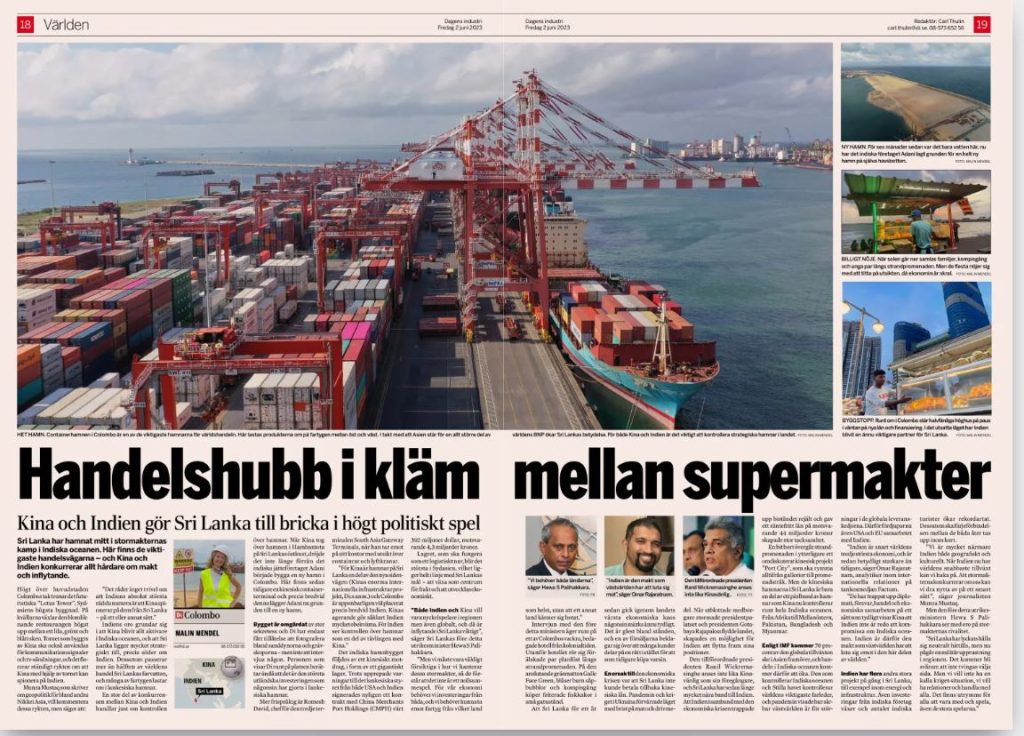Nyhetsbrev 1 juni 2023
DI om Sri Lanka
Dagens Industri skriver om Sri Lanka och relationen Kina – Indien.
https://www.di.se/nyheter/mitt-i-kampen-mellan-indien-och-kina/

THREE QUICK ONES – KERSTIN THULIN
3 quick ones to Kerstin Thulin new board member of SSLBC. She has a long international career in leading positions within IT, telecom, and shipping. Kerstin has worked in Sri Lanka, Oman, India, and several African countries.

What is your relationship with Sri Lanka?
I first came to Sri Lanka in 1983 when I had the opportunity to adopt one of my daughters. It was an overwhelming experience during the burning civil war. In 1996, I was asked to help set up the telecom company Suntel in Sri Lanka with responsibility for HR, organization and culture. It was an intense two years where I got to meet a competent and language-savvy workforce. Many years later, I was asked to sit on the board of the Sri Lankan Children’s Association (SLBV), supporting vulnerable children and young people to make a difference in their lives and futures.
What are your driving forces?
Basically, I am a curious and stubborn entrepreneur. I have a curiosity for people and cultures – not only corporate culture. I want to help build value-driven organizations, which has been a common thread throughout my career. When I started my career, the HR function was relatively obscure, reporting to the Chief Financial Officer. A lot has happened since then. I have sat on several management teams of international telecom companies with responsibility for HR and Organization. Modern organizations need to value culture and organizational issues as business critical. There is no alternative.
What do you want to contribute to the work of the board?
I hope to contribute with my many years of experience within IT and telecom. Sri Lanka has a growing high-end IT sector. Too few in the Swedish business community are aware of this. I want to help raise awareness, both of the sector specifically and of Sri Lanka in general. I also hope to share my experience of developing corporate cultures and value-driven organizations with our members in various ways.
What is your relationship with Sri Lanka?
I first came to Sri Lanka in 1983 when I had the opportunity to adopt one of my daughters. It was an overwhelming experience during the burning civil war. In 1996, I was asked to help set up the telecom company Suntel in Sri Lanka with responsibility for HR, organization and culture. It was an intense two years where I got to meet a competent and language-savvy workforce. Many years later, I was asked to sit on the board of the Sri Lankan Children’s Association (SLBV), supporting vulnerable children and young people to make a difference in their lives and futures.
What are your driving forces?
Basically, I am a curious and stubborn entrepreneur. I have a curiosity for people and cultures – not only corporate culture. I want to help build value-driven organizations, which has been a common thread throughout my career. When I started my career, the HR function was relatively obscure, reporting to the Chief Financial Officer. A lot has happened since then. I have sat on several management teams of international telecom companies with responsibility for HR and Organization. Modern organizations need to value culture and organizational issues as business critical. There is no alternative.
What do you want to contribute to the work of the board?
I hope to contribute with my many years of experience within IT and telecom. Sri Lanka has a growing high-end IT sector. Too few in the Swedish business community are aware of this. I want to help raise awareness, both of the sector specifically and of Sri Lanka in general. I also hope to share my experience of developing corporate cultures and value-driven organizations with our members in various ways.
Industry 2023 – Sri Lanka Colombo
DANISH REPORT ABOUT SRI LANKA
This guide gives you a brief introduction to the
Sri Lankan innovation and business ecosystem, with
special focus on the city of Colombo, where most of the
key industries and stakeholders are located.
In addition, the report highlights a series of strongholds
of the country’s economy.
Newsletter from ECCSL – article about SSLBC member
Newsletter from our partner in Sri Lanka – European Chamber of Commerce in Sri Lanka.
In the newsletter you will find an article about our member Villa Vanna and the owner Lisa Enström.
Underlag seminarium Business Sweden
Presentationsunderlaget från Busniess Sweden seminarium i april 2023.
Nyhetsbrev Sri Lanka 25 2023′
Growing differences in growth – Asia is pulling away
Stefan Karlsson, chief analyst at EKN, presents his latest global outlook for 2023. Sweden’s exports are going strong, global inflation is finally on the way down – and export companies should be aware that Asia will increasingly become the world’s engine of growth.
What is the state of the world economy really like?
- According to the IMF’s latest forecast, the economy will bottom out this year and then turn upwards. However, the forecast shows that global economic growth will be weaker this year and next year than it was in 2022. However, it depends on where in the world you look – the difference in growth rate between Asia and other regions increases during the year. This year, for example, the euro area is expected to grow by 0.8 percent while Asia grows by 5.3 percent. And, which is important for Swedish export companies to think about, Asia is no longer just a region to trade from. 35 percent of all world imports go to countries in the region.
And what does inflation look like around the world?
- The historically high inflation, especially in the OECD’s high-income countries, is considered to have peaked and is now gradually falling. In the United States, it peaked in June 2022 and has fallen every month since. The annual rate was 3.9 percent in March, while the key interest rate is five percent. The European and Swedish central banks have been later in the interest rate hike cycle. In May, their key interest rates were 3.75 percent and 3.5 percent, respectively. For all three central banks, interest rate increases are expected to end during the summer, although it is not unlikely that another increase could follow in the autumn.
What does this mean for Swedish exports?
- Swedish exports are going well! Swedish goods exports developed strongly last year, helped by a weak krona. The increase in value was a total of 23 percent, but in the increasingly important Asia the increase amounted to a more modest 16 percent. During the first two months of 2023, merchandise exports continued to increase by 17 percent. Exports to EU countries remain strong with an increase of 20 percent, while exports to Asia are again increasing less than to other regions.
Finally, can we make some cuts to how things look in key export markets?
- Latin America
- Swedish exports to Latin America increased by a whopping 47 percent last year. In 2023, however, growth in the region is expected to amount to a weak 1.6 percent, which makes the region the weakest growing with the exception of Eastern Europe, where the conflict in Ukraine affects growth. Many countries, including Brazil and Chile, are battling inflation, falling export earnings, weak production data and rising unemployment.
- Asia
- In Asia, with China and India at the forefront, strong growth will continue in the coming years. The fact that China’s economic cycle is out of phase with the rest of the world is due to the dismantling of the strict covid strategy at the end of December 2022. After low GDP growth in 2022, three percent, the economy is now at the beginning of a recovery phase. In India and Southeast Asia, growth remains robust – 5.9 percent in India and 4.5 percent in Southeast Asia. In general, Asia has not been hit as hard by inflation as Europe and North America, and even here inflation has probably already passed its peak.
- Europe and North America
The euro area, the rest of Europe and the US will be in a continued high inflation environment in 2023 and this contributes to subdued economic activity. With growth figures of between 0.8 and 1.6 percent for the year, the ”West” is growing the slowest in the world this year, along with Latin America. In the next year, US growth drops further to 1.1 percent. Eurozone growth is increasing slightly, but even in 2024, the OECD countries thus exhibit the lowest growth in the world.
Are you thinking about exporting?


